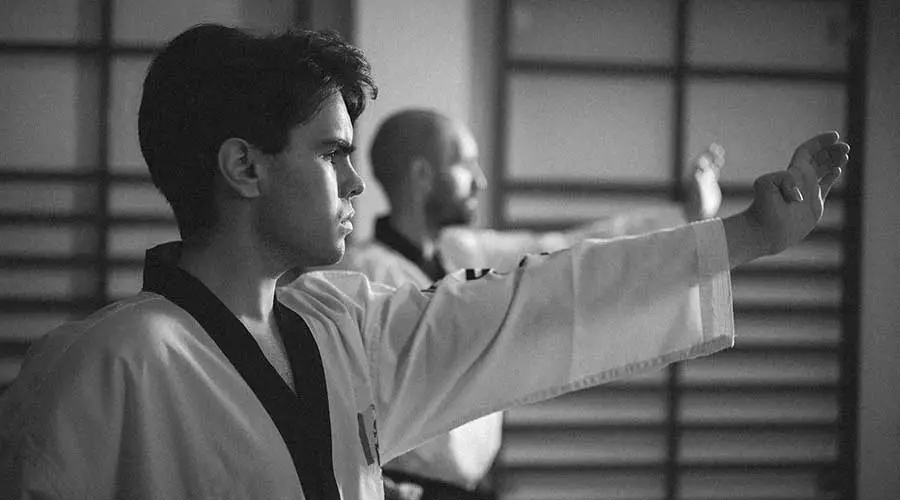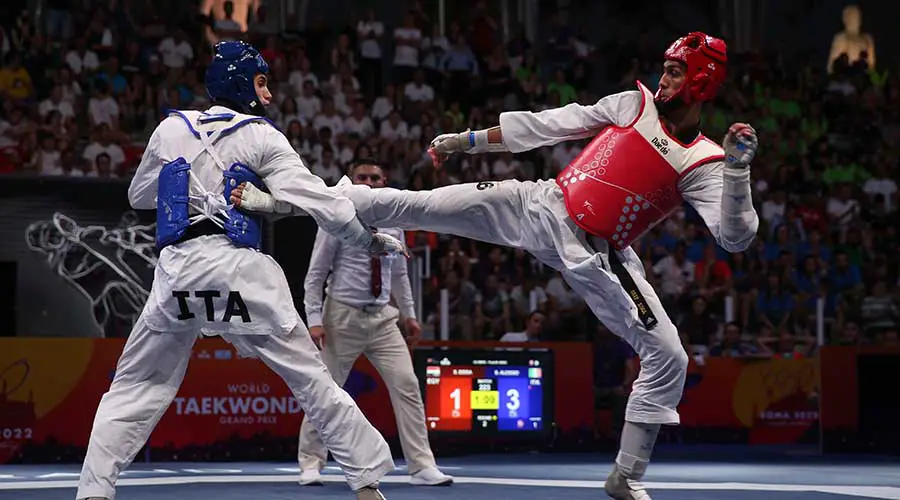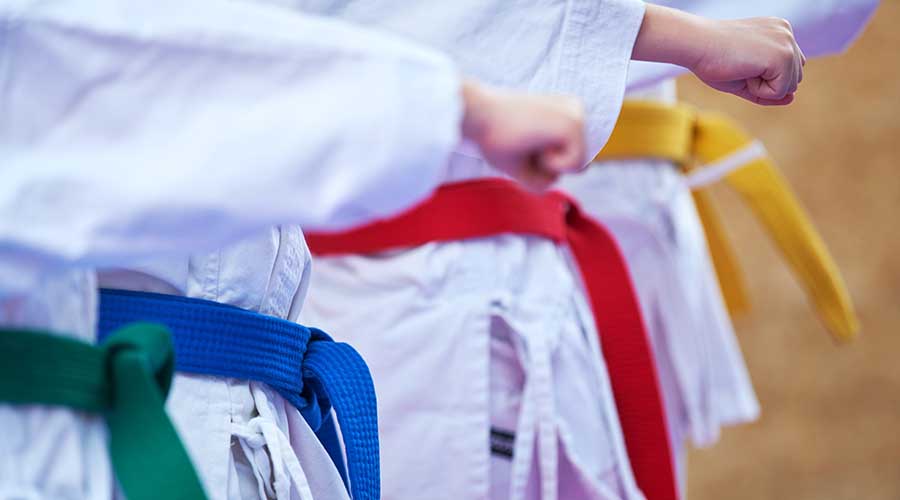Taekwondo is a martial art of Korean origin characterised by the use of kicks and punches for self-defence and competition.
In this complete and up-to-date guide, you’ll learn all about this sport, which is one of the most widely practised in the world.
We’ll explain the history, the rules, the main blows, the equipment used, the grading of belts and how the fights work.
Are you curious? Then check it out 👇
What is taekwondo?
Taekwondo is a South Korean martial art known for its kicking, punching, kneeing and elbowing techniques.
The word taekwondo is derived from three Korean terms: “tae” (foot), “kwon” (fist) and “do” (way). Therefore, the name of the sport can be translated into something like “the way of the feet and hands”.
The fight is a combination of ancient self-defence techniques, traditional Korean martial arts and influences from other cultures.
Taekwondo is known for its emphasis on powerful and precise attacks, especially kicks, which are often thrown from a long distance.
In addition to the physical aspects, the sport also incorporates ethical and moral values into its training, including respect, courtesy, integrity, perseverance, self-control and indomitable spirit.
In the competitive sphere, taekwondo is practised professionally in many countries around the world. In tournaments, athletes earn points for applying precise, controlled techniques to their opponents without using violence.
Taekwondo history

Taekwondo is a Korean martial art. Its development dates back to the time of the Three Kingdoms of Korea, which spanned the 6th to 9th centuries.
The first forms of fighting that eventually evolved into the sport we know today were practised by the warriors of these kingdoms.
Modern taekwondo, however, began to take shape after the Japanese occupation of Korea at the beginning of the 20th century.
During this period, many Korean cultural and sporting practices were banned, forcing the inhabitants to adopt Japanese martial arts training methods.
After the liberation of Korea in 1945, there was a movement to recover and revitalise Korean cultural traditions, including fighting.
Thus, various schools and organisations were founded to develop and promote a unified form of martial art, which was named taekwondo.
In 1955, the Korean Taekwondo Association was established, consolidating fighting as a professional and regulated sport.
The sport gained more and more momentum, culminating in the emergence of championships not only in South Korea, but all over the world. From the 1990s onwards, taekwondo was already a global phenomenon.
It was no wonder that, in 2000, the sport was included in the Olympic programme. It made its debut at the Sydney Games in Australia.
Taekwondo rules

- Objective | In taekwondo fights, the person who accumulates the most points wins. To score points, the competitor needs to land blows to the opponent’s chest or head. These parts of the body are duly protected with padded equipment designed to absorb impacts
- Duration | The fights consist of three rounds of two minutes each. In between rounds, competitors have one minute to rest, review tactics and talk to coaches.
- Scoring | Punches to the chest are worth one point, kicks to the chest are worth two points, kicks to the head are worth three points, spinning kicks to the chest are worth four points and spinning kicks to the head are worth five points.
- Technology | The blows are calculated using chips and sensors installed in the competitors’ equipment. Thus, when a technique is landed, the score is automatically updated.
- Refereeing | Despite the technology, referees are assigned to supervise the fights and make sure everything is going smoothly. The judges can even apply penalties if necessary.
- Victory conditions | Victory in taekwondo can be achieved in several ways. They are: scoring more points than the opponent at the end of regulation time, reaching a 20-point difference at the end of the second round, knocking out the opponent or winning by disqualifying the opponent if they break any rules.
- Tie-breaker | If the competitors finish the regulation time tied on points, a one-minute fourth round is played. In this kind of extra time, the first competitor to score two points is declared the winner of the match. If the tie persists, the decision is left to the referees, who will use specific criteria.
- Punishments | During a fight, opponents may not: cross the boundary line of the mat, fall, avoid the fight, hold or push the opponent, land kicks below the waist, strike the head with their hands, headbutt the opponent or attack the fallen opponent. If this is done, the competitor is penalised with a gam-jeon and the opponent receives one point.
Taekwondo equipment
During duels, competitors must wear protectors on the chest, head, legs and genital area. This equipment must be placed on top of the dobok, which is the taekwondo fighting garment.
To differentiate themselves in combat, one athlete wears red protectors (hong), while the other wears blue protectors (tchong).
Taekwondo weight classes (men)
- Flyweight: up to 58kg
- Lightweight: between 58 and 68 kg
- Middleweight: between 68 and 80 kg
- Heavyweight: over 80 kg
Taekwondo weight classes (women)
- Flyweight: up to 49kg
- Lightweight: between 49 and 57 kg
- Middleweight: between 57 and 67 kg
- Heavyweight: over 67 kg
Taekwondo belts

Taekwondo has a grading system based on coloured belts, which symbolise the practitioner’s level of skill and knowledge.
Each belt has a specific colour and represents a different stage in the student’s development. Check them out below:
- White (10th gub): represents innocence and lack of knowledge. It is the initial belt for new practitioners;
- Yellow (9th gub): symbolises the earth where seeds are planted and begin to grow. It represents the beginning of the development of taekwondo skills;
- Yellow with a green tip (8th gub): indicates the growth of plants and the advancement of skills in learning the martial art;
- Green (7th gub): represents the continued development of the skills and knowledge of the sport;
- Green with blue tip (6th gub): signals the maturity of the practitioner;
- Blue (5th gub): symbolises the sky where the plant grows strong and healthy;
- Blue with a red tip (4th gub): indicates the practitioner’s maturity;
- Red (3rd gub): represents danger, as the practitioner acquires more skills and becomes more aware of their capabilities;
- Red with a black tip (2nd gub): signals the transition to the more advanced levels of taekwondo;
- Black (1st dan onwards): the black belt symbolises mastery of all the fundamental taekwondo skills. From there, practitioners can progress through dans (degrees of mastery).
Now you know all about taekwondo! Did you like this content? Let us know in the comments! And keep following us every day for more articles on sports, games and betting 👊



